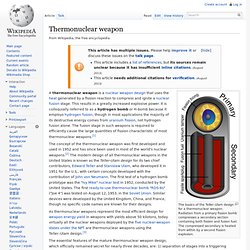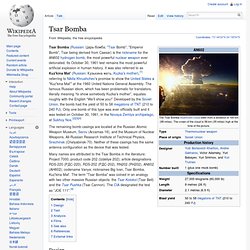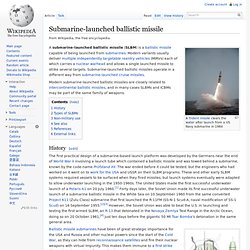

Achieve - Teller–Ulam design. The basics of the Teller–Ulam design for a thermonuclear weapon.

Radiation from a primary fission bomb compresses a secondary section containing both fission and fusion fuel. The compressed secondary is heated from within by a second fission explosion. A thermonuclear weapon is a nuclear weapon design that uses the heat generated by a fission reaction to compress and ignite a nuclear fusion stage. This results in a greatly increased explosive power.
It is colloquially referred to as a hydrogen bomb or H-bomb because it employs hydrogen fusion, though in most applications the majority of its destructive energy comes from uranium fission, not hydrogen fusion alone. As thermonuclear weapons represent the most efficient design for weapon energy yield in weapons with yields above 50 kilotons, today virtually all the nuclear weapons deployed by the five nuclear-weapon states under the NPT are thermonuclear weapons using the Teller–Ulam design.[3] Basic principle[edit] Summary[edit]
Achieve - Tsar Bomba. Coordinates: 73°48′26″N 54°58′54″E / 73.80722°N 54.98167°E / 73.80722; 54.98167 Tsar Bomba (Russian: Царь-бомба; "Tsar Bomb", "Emperor Bomb", Tsar being derived from Caesar) is the nickname for the AN602 hydrogen bomb, the most powerful nuclear weapon ever detonated.

Its October 30, 1961 test remains the most powerful artificial explosion in human history. It was also referred to as Kuz'kina Mat' (Russian: Кузькина мать, Kuzka's mother),[1] referring to Nikita Khrushchev's promise to show the United States a "Kuz'kina Mat'" at the 1960 United Nations General Assembly. The famous Russian idiom, which has been problematic for translators, literally meaning “to show somebody Kuzka's mother”, equates roughly with the English “We’ll show you!” Developed by the Soviet Union, the bomb had the yield of 50 to 58 megatons of TNT (210 to 240 PJ). Design[edit] Site of the detonation A Tsar Bomba-type casing on display at Sarov Test[edit] Analysis[edit] Films[edit] See also[edit] References[edit] Achieve - Submarine-launched ballistic missile. A Trident missile clears the water after launch from a US Navy submarine in 1984 A submarine-launched ballistic missile (SLBM) is a ballistic missile capable of being launched from submarines.

Modern variants usually deliver multiple independently targetable reentry vehicles (MIRVs) each of which carries a nuclear warhead and allows a single launched missile to strike several targets. Submarine-launched ballistic missiles operate in a different way from submarine-launched cruise missiles. Modern submarine-launched ballistic missiles are closely related to intercontinental ballistic missiles, and in many cases SLBMs and ICBMs may be part of the same family of weapons. History[edit] Ballistic missile submarines have been of great strategic importance for the USA and Russia and other nuclear powers since the start of the Cold War, as they can hide from reconnaissance satellites and fire their nuclear weapons with virtual impunity.
Types of SLBMs[edit] Soviet Union / Russian Federation France.